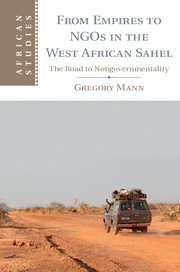5 - Governing Famine
Published online by Cambridge University Press: 05 January 2015
Summary
Circa 1960, the Sahel boasted a bright future, at least in the vision of the region’s planners. Yet by the early 1970s that future was fading fast. Rains had failed for several years, and the huge herds of the 1950s and 1960s were dying for want of pasture. In 1973 and early 1974, drought and famine seemed to foreclose the possibility of an agriculturally productive Sahelian zone, one whose livestock would fuel new national economies and help feed southern neighbors. That particular Sahelian future was no longer ambitious, it was delusional. In the absence of rain, the herds themselves seemed to shrivel. In Niger, the river ran so low that, for the first time in living memory, giraffes could ford it. Farmers watched their fields burn under the sun. Their crops would be scorched, never harvested. The exodus of tens of thousands of pastoralists and nomads, and smaller numbers of farmers, appeared unstoppable and irreversible. Many were not expected to survive. Those predictions would prove too dire, but displaced pastoralists who had taken refuge in Niger’s cities thought that it would take years to reconstitute their herds. Meanwhile foreign analysts, like emergency room doctors, proposed extreme measures over what seemed to them an inanimate and unfamiliar form, which some saw as an inert body politic, others as its carcass. An international conference in July 1973 proposed “evacuating” the Sahel entirely. To that idea Senegalese President Léopold Sedar Senghor responded sharply, riposting that African civilization would thereby lose one of its defining traits, and “not the least noble, not the least beautiful.” Still, journalists wrote obituaries for an entire region that was “slipping out of human use.” By their reckoning, the future of the Sahel was not only parched, it was impossible. This was the end of the road.
- Type
- Chapter
- Information
- From Empires to NGOs in the West African SahelThe Road to Nongovernmentality, pp. 170 - 208Publisher: Cambridge University PressPrint publication year: 2014
References
- 1
- Cited by

